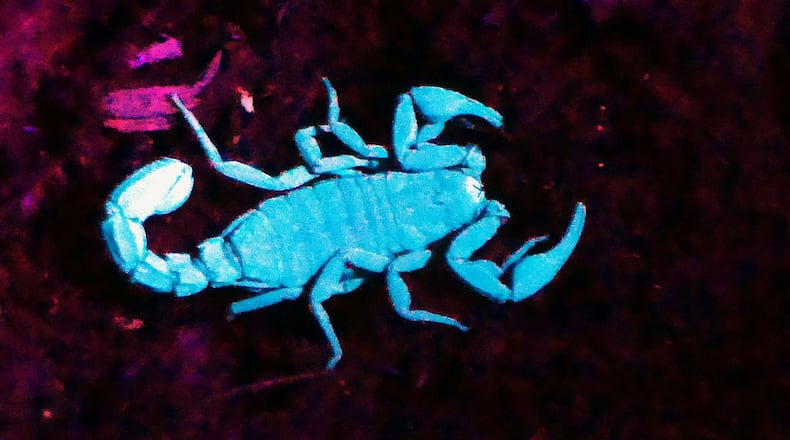You might think of scorpions as denizens only of hot, dry deserts. But scorpions are amazingly adaptable, found around the world in habitats ranging from tropical rain forests to Southern piney woods.
That includes Georgia, where two species, each about an inch long, occur in different parts of the state. The Southern devil scorpion, also called the Southern stripeless scorpion, lives in the Piedmont and the mountains of central and North Georgia. The striped bark scorpion occurs in Coastal Plain pine woods and sandy soil areas.
Scorpions also may be found in yards and sometimes in homes, where they may fall into a sink or bathtub and get trapped.
On a pitch black night last weekend, we looked for devil scorpions along a woodland trail in Hard Labor Creek State Park in Morgan County. Before we set out, our leader, park naturalist Jenna McLoughlin, gave us some special sticks and ultraviolet light flashlights. The sticks, we learned, were for spreading apart leaf litter around old logs where devil scorpions usually live. The UV lights were for easily spotting the nocturnal creatures, whose fluorescent bodies glow at night under UV light.
We found 15 scorpions during our hour-long trek. Along the way, McLoughlin explained that scorpions are arachnids, in the same class with spiders. Scorpions are easily recognizable with their front pinchers and long tail, which may be curled or flat. If threatened, a scorpion will raise its tail high above its back.
The bulbous shape at the end of the tail has a hook-shaped stinger. If provoked, Georgia’s scorpions may sting with the strength of a bee. Scorpions, though, are highly beneficial because they prey upon a variety of pesky insects.
IN THE SKY: From David Dundee, Tellus Science Museum astronomer: The Eta Aquarid meteor shower reaches a peak of about 60 meteors per hour this weekend in the southeast sky. Best viewing time: about 3 a.m. until dawn.
The moon, new today, will “grow“ to first quarter by next Friday. Venus is low in the east just before sunrise. Mars is very low in the west around dusk and sets about two hours later; it will appear near the moon on Tuesday. Jupiter rises out of the east before midnight; Saturn does so a few hours later.
About the Author
Keep Reading
The Latest
Featured


